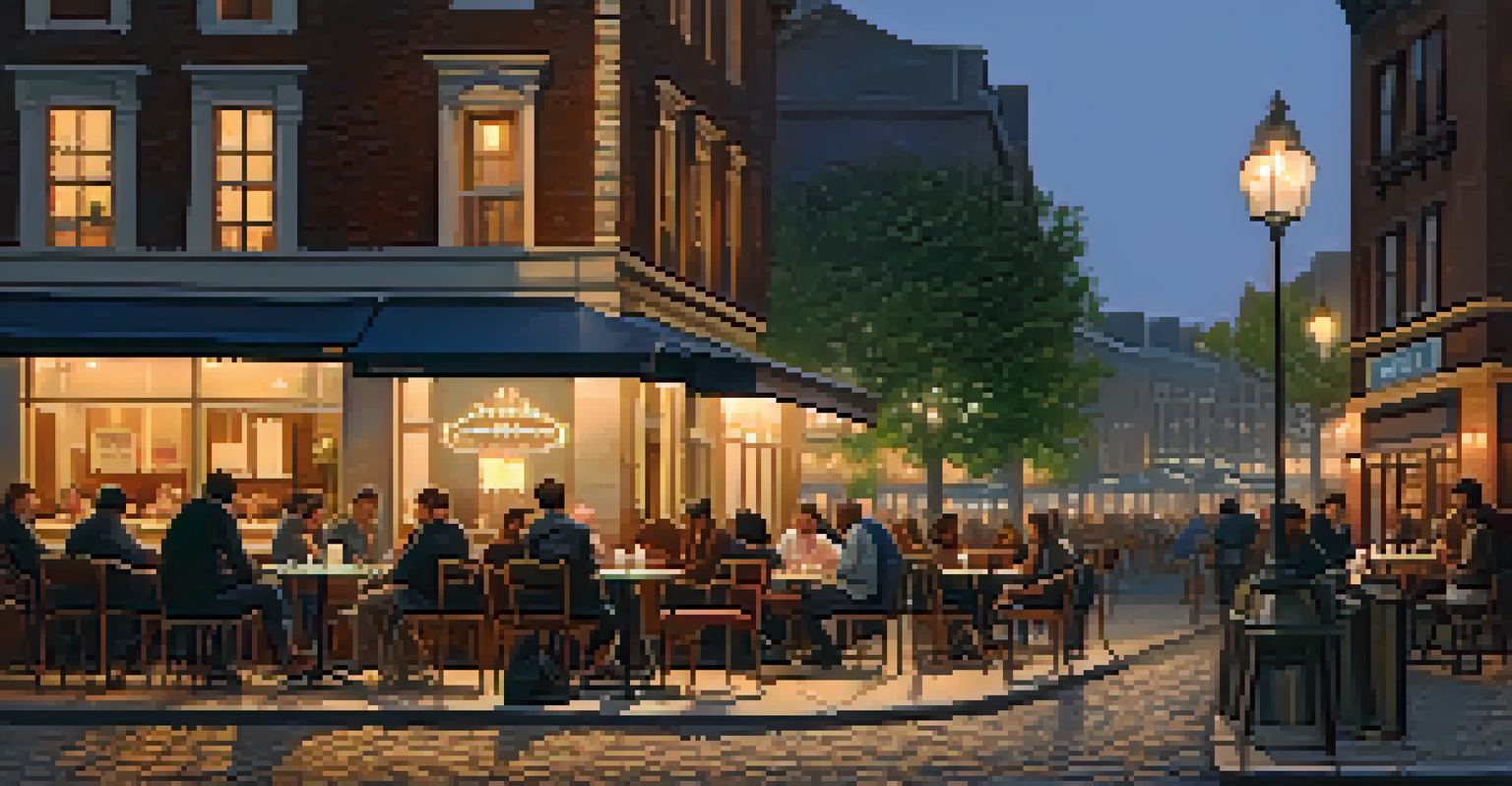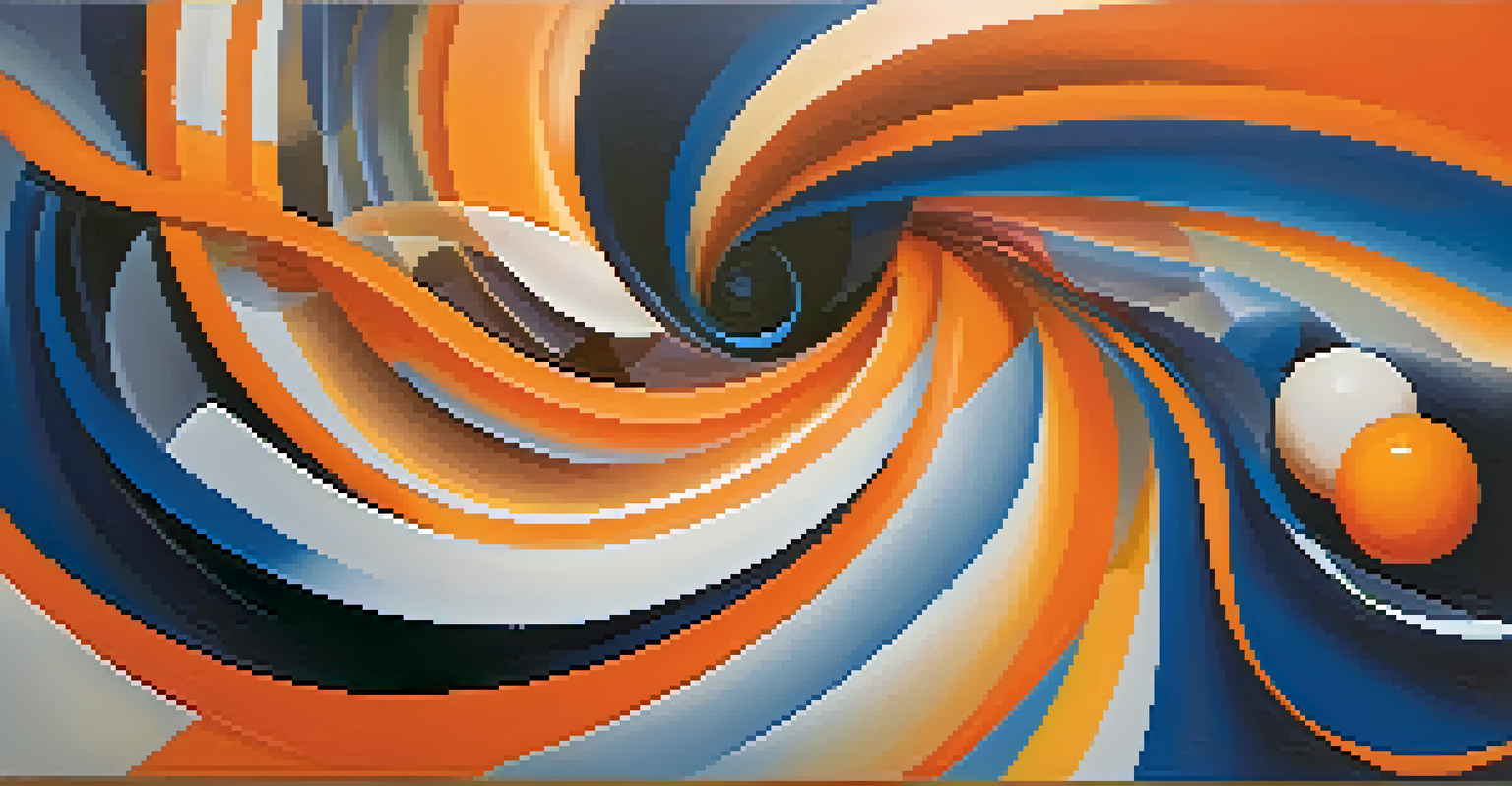Artistic Timeframes: The Influence of Art Movements on Each Other

Understanding Art Movements and Their Contexts
Art movements are collective styles or philosophies that define a particular period in art history. Each movement reflects the social, political, and cultural contexts of its time, influencing how artists express their ideas. For instance, the Impressionist movement emerged during the late 19th century, focusing on light and color, as a reaction against the rigid standards of academic art.
Every artist dips his brush in his own soul, and paints his own nature into his pictures.
By understanding these movements, we can see how they serve as reactions to one another, creating a tapestry of artistic expression. The fluidity between movements often leads to overlaps, where one movement borrows ideas from another, enriching the art world. This interconnectedness is crucial in understanding the evolution of artistic practices.
Exploring these contexts helps us appreciate not just the art itself but also the myriad influences that shaped it. Each movement can be viewed as a response to the challenges and innovations that preceded it, leading to a continuous dialogue across generations of artists.
The Impact of Romanticism on Realism
Romanticism, which flourished in the late 18th and early 19th centuries, emphasized emotion and individualism, often depicting dramatic scenes from nature or human experiences. This movement set the stage for Realism, which emerged as a counter-response in the mid-19th century, striving to portray everyday life without embellishment. Artists like Gustave Courbet focused on the lives of ordinary people, moving away from the grandeur of Romantic ideals.

The transition from Romanticism to Realism illustrates how one movement can challenge the conventions of another. While Romantics sought to evoke emotions through idealized forms, Realists aimed to ground art in the mundane, showcasing the beauty in simplicity. This shift reflects a broader societal change, where industrialization and social issues began to shape artistic expression.
Art Movements Reflect Their Times
Art movements are shaped by the social, political, and cultural contexts of their eras, influencing how artists express their ideas.
As artists navigated these shifts, they laid the groundwork for future movements, such as Impressionism, which would further explore the interplay between light and reality. The dialogue between Romanticism and Realism highlights the continuous evolution of artistic thought, demonstrating how movements can influence one another profoundly.
Impressionism: A Reaction to Realism and Academic Art
Impressionism emerged in the late 19th century as a radical departure from the detailed realism that preceded it. Artists like Claude Monet and Pierre-Auguste Renoir sought to capture fleeting moments of light and color, often painting en plein air, or outdoors. This approach was a direct response to the constraints of academic art, which emphasized meticulous detail and historical themes.
Art is not what you see, but what you make others see.
The Impressionists' focus on everyday subjects and natural scenes marked a significant shift in artistic priorities. They emphasized perception over accuracy, inviting viewers to experience art in a new way. This movement challenged the established norms, encouraging artists to explore their individual styles and interpretations.
As Impressionism gained traction, it inspired subsequent movements like Post-Impressionism, which further pushed the boundaries of color and form. The legacy of Impressionism is evident in its influence on modern art, demonstrating how one movement can pave the way for innovation while responding to the artistic conventions of its time.
Post-Impressionism: Building on Impressionist Foundations
Post-Impressionism emerged in the late 19th century as artists sought to extend the ideas of Impressionism while adding their personal interpretations. Artists like Vincent van Gogh and Paul Cézanne experimented with color, form, and perspective, moving beyond the fleeting impressions of light. This movement marked a transition towards modern art, emphasizing emotional depth and structural composition.
While Impressionism focused on capturing the moment, Post-Impressionism delved deeper into the emotional resonance of art. For instance, van Gogh's expressive brushwork and vivid colors convey intensity and personal experience, while Cézanne's geometric forms laid the groundwork for future abstract movements. This evolution highlights how artists can reinterpret existing styles to communicate new ideas.
Romanticism to Realism Shift
The transition from Romanticism to Realism illustrates how one movement can challenge and redefine the conventions of another.
The dialogue between Impressionism and Post-Impressionism underscores the importance of individual expression within a broader artistic framework. Each artist's unique approach contributed to a more diverse understanding of what art could be, paving the way for movements like Fauvism and Cubism.
Fauvism: Embracing Color and Emotion
Fauvism emerged in the early 20th century, characterized by bold colors and simplified forms. Artists like Henri Matisse and André Derain rejected traditional representation, opting instead for a vibrant palette that emphasized emotional expression. This movement can be seen as a direct response to the restrained nature of Post-Impressionism, pushing color to the forefront of artistic expression.
The Fauves believed that color could convey feelings, often using it in non-representational ways to evoke a sense of joy or turmoil. Their work challenged the conventional understanding of color, inspiring future movements that prioritized emotional impact over realism. This radical approach opened doors for abstraction and modernism.
Fauvism's legacy is evident in the way it liberated color in art, influencing later movements like Expressionism and Abstract Expressionism. By emphasizing the power of color, Fauvism demonstrated how art could be a vehicle for emotional truth, forever changing the landscape of artistic expression.
Cubism: Deconstructing Form and Perspective
Cubism, pioneered by artists such as Pablo Picasso and Georges Braque, emerged in the early 20th century as a revolutionary way of seeing and representing the world. This movement sought to break down objects into geometric shapes and present multiple perspectives simultaneously. In many ways, Cubism can be viewed as a response to the limitations of traditional representation, challenging viewers to engage with art in a more abstract way.
By deconstructing form, Cubism encouraged artists to explore new dimensions of reality, moving away from the representational style that had dominated prior movements. This radical approach not only influenced painting but also extended to sculpture and collage, showcasing the versatility of artistic expression. The innovative techniques used by Cubists reshaped the art world, paving the way for various modernist movements.
Surrealism's Lasting Impact
Surrealism's focus on the unconscious mind has profoundly influenced contemporary art, encouraging innovation and experimentation.
Cubism's impact is seen in the works of later artists who embraced abstraction, allowing them to push the boundaries of creativity further. This movement fundamentally changed the way art was understood, encouraging a departure from traditional techniques and inspiring a new wave of artistic exploration.
The Influence of Surrealism on Contemporary Art
Surrealism, which emerged in the 1920s, sought to tap into the unconscious mind, creating dream-like scenes that challenged reality. Artists like Salvador Dalí and René Magritte used bizarre juxtapositions and unexpected imagery to provoke thought and evoke emotions. This movement can be seen as a reaction to the rationalism of the preceding era, opening up new avenues for artistic exploration.
Surrealism's emphasis on imagination and the subconscious has had a lasting impact on contemporary art. Many modern artists draw inspiration from Surrealist techniques, using symbolism and abstraction to express complex ideas and emotions. This legacy is evident in various art forms, from visual arts to literature and film.

The dialogue between Surrealism and contemporary art highlights the importance of innovation and experimentation in artistic practice. By breaking away from traditional narratives, Surrealism has encouraged artists to explore their inner worlds, leading to a richer understanding of human experience through art.